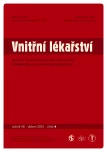Drug interactions in the elderly with diabetes mellitus
Authors:
T. Hendrychová; J. Vlček
Authors‘ workplace:
Katedra sociální a klinické farmacie Farmaceutické fakulty UK Hradec Králové, vedoucí prof. RNDr. Jiří Vlček, CSc.
Published in:
Vnitř Lék 2012; 58(4): 299-304
Category:
Reviews
Overview
The elderly with diabetes mellitus are usually treated with many types of drugs. This, together with pharmacokinetic and pharmacodynamic changes connected with aging, can lead to an occurence of drug interactions. They are often manifested as hypoglycaemia, decompensation of diabetes or an increase of frequency of adverse effects of drugs used together. It is important to pay an attention especially to hypoglycaemia, which brings many risks in the elderly. An article is focused on probable drug interactions when combination of various antidiabetics, antidiabetics with antihypertensives or hypolipidemics is used. Despite ACE-inhibitors and beta-blockers can influence the compensation of diabetics, their use is not contraindicated in these patients, because of their huge benefit in the prevention of cardiovascular events. An article brings an overview of antidiabetics metabolised by means of the system of cytochrome P 450 and resulting drug interactions with inhibitors and inductors of these enzymes. These drug interactions are not usually important in clinical practice and it is possible to prevent them with careful monitoring of glycaemia, instruction of patients and alternatively modification of the doses of hypoglycaemic medication after a termination of the treatment of responsible inductor or inhibitor.
Key words:
drug interaction – diabetes mellitus – antidiabetics – cytochrome P 450 – hypoglycaemia
Sources
1. Turnheim K. When drug therapy gets old: pharmacokinetics and pharmacodynamics in the elderly. Exp Gerontol 2003; 38: 843–853.
2. Květina J, Grundmann M. Farmakologická interakce. Klin Farmakol Farm 2003; 1: 17–21.
3. Oiknine R, Mooradian AD. Drug therapy of diabetes in the elderly. Biomed Pharmacother 2003; 57: 231–239.
4. Herrlinger C, Klotz U. Drug metabolism and drug interactions in the elderly. Best Pract Res Clin Gastroenterol 2001; 15: 897–918.
5. Cayea D, Boyd C, Durso SC. Individualising therapy for older adults with diabetes mellitus. Drugs Aging 2007; 24: 851–863.
6. Wolff JL, Starfield B, Anderson G. Prevalence, expenditures, and complications of multiple chronic conditions in the elderly. Arch Intern Med 2002; 162: 2269–2276.
7. Niefeld MR, Braunstein JB, Wu AW et al. Preventable hospitalization among elderly medicare beneficiaries with type 2 diabetes. Diabetes Care 2003; 26: 1344–1349.
8. Prokeš M. Lékové interakce u diabetiků v ČR. Interní Med 2008; 10: 562–566.
9. Suchopár J et al. Kompendium lékových interakcí. Infopharm 2005. Praha: Infopharm a. s. 2004.
10. Beyth RJ, Shorr RI. Epidemiology of adverse drug reactions in the elderly by drug class. Drugs Aging 1999; 14: 231–239.
11. Škrha J. Hypoglykémie – důležitý fenomén moderní léčby diabetu mellitu. Remedia 2008; 18 (Suppl 1): S34–S41.
12. Šmahelová A. Perorální antidiabetika skupiny derivátů sulfonylurey. Remedia 2008; 18 (Suppl 1): S56–S60.
13. Abbatecola AM, Paolisso G, Corsonello A. Antidiabetic oral treatment in older people. Does frailty matter? Drugs Aging 2009; 26 (Suppl 1): 53–62.
14. Scheen AJ. Drug interactions of clinical importance with antihyperglycaemic agents: An update. Drug Saf 2005; 28: 601–631.
15. Databáze registrovaných léčivých přípravků SÚKL [online]. [cit. 18. 7. 2011]. Dostupný na WWW: http://www.sukl.cz/modules/medication/search.php.
16. MICROMEDEX®2.0 [Online]. [cit. 1. 8. 2011]. Dostupný na WWW: http://www.thomsonhc.com/micromedex2/librarian/.
17. Perušičová J. Exenatid. Remedia 2008; 18 (Suppl 1): S18–S23.
18. Kvapil M. Sitagliptin. Remedia 2008; 18 (Suppl 1): S4–S10.
19. Scheen AJ. Pharmacokinetics interactions with thiazolidinediones. Clin Pharmacokinet 2007; 46: 1–12.
20. Scheen AJ. Dipeptidylpeptidase-4 inhibitors (gliptins): Focus on drug-drug interactions. Clin Pharmacokinet 2010; 49: 573–588.
21. Scheen AJ. Drug-drug and food-drug pharmacokinetic interactions with new insulinotropic agents repaglinide and nateglinide. Clin Pharmacokinet 2007; 46: 93–108.
22. Fialová D, Vlček J, Pelíšková D et al. Metabolické interakce ve stáří a faktory ovlivňující jejich klinickou významnost. Prakt Lékáren 2006; 2: 76–80.
23. Kousalová L, Baranová J, Anzenbacher P. Lékové interakce na úrovni cytochromů P 450 – část I. Interakce na úrovni CYP 3A4. Klin Farmakol Farm 2003; 17: 151–157.
24. Doporučený postup péče o diabetes mellitus 2. typu [online]. Česká diabetologická společnost 2011. [citováno 19.7.2011]. Dostupný na : http://www.diab.cz/dokumenty/dm2_2011.pdf.
25. Nathan DM, Buse JB, Davidson MB et al. European Association for Study of Diabetes. Medical management of hyperglycemia in type 2 diabetes: a consensus algorithm for the initiation and adjustment of therapy: a consensus statement of the American Diabetes Association and the European Association for the Study of Diabetes. Diabetes Care 2009; 32: 193–203.
26. Bláha V, Mistrík E. Hypolipidemika a diabetes mellitus. Vnitř Lék 2009; 55: 357–362.
27. Alsheikh-Ali AA, Karas RH. Adverse Events With Concomitant Use of Simvastatin and Thiazolidinediones. Am J Cardiol 2004; 93: 1417–1418.
28. Souček M. Cílové hodnoty krevního tlaku u pacientů s diabetes mellitus. Vnitř Lék 2009; 55: 363–367.
29. Thamer M, Ray NF, Taylor T. Association Between Antihypertensive Drug Use and Hypoglycemia: A Case-Control Study of Diabetic Users of Insulin or Sulfonylureas. Clin Ther 1999; 21: 1387–1400.
30. Shorr RI, Ray WA, Daugherty JR et al. Antihypertensives and the risk of serious hypoglycemia in older persons using insulin or sulfonylureas. JAMA 1997; 278: 40–43.
31. UK Prospective Diabetes Study Group. Efficacy of atenolol and captopril in reducing risk of macrovascular and microvascular complications in type 2 diabetes: UKPDS 39. Brit Med J 1998; 317: 713–720.
32. Prokeš M, Suchopár J. Lékové interakce vybraných léků užívaných pacienty s diabetes mellitus. Vnitř Lék 2009; 55: 395–402.
33. Sadloňová J. Možnosti hormonální antikoncepce a substituce u diabetiček. Vnitř Lék 2009; 55: 375–383.
Labels
Diabetology Endocrinology Internal medicineArticle was published in
Internal Medicine

2012 Issue 4
Most read in this issue
- Pervitin induced acute myocardial infarction
- The importance of NGAL and cystatin C biomarkers in cardiovascular diseases
- Acute copper poisoning by suicidal attempt
- New knowledge of the pathogenesis of Crohn’s disease
